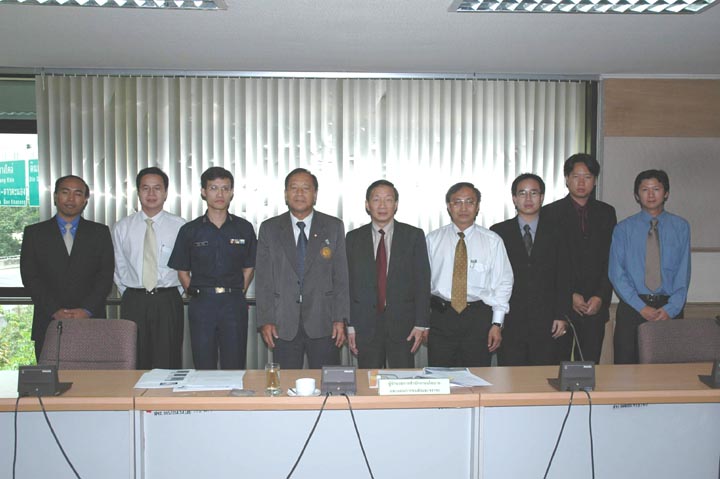
The AIT team, from left: Mr. Surak Piyaraksakul, Dr. Sun Sayamipuk, Dr. Pichai Nimityongskul, Dr. Thanakorn Pheeraphan of RTAF, Mr. Rattapoom Parishartpreecha, and Mr. Watwong Kareepala
AIT Team Conducts Experimental Study of Hopewell Project's Structures
In February 2005, an AIT team, led by Dr. Pichai Nimityongskul, Coordinator of Structural Engineering Field of Study, School of Civil Engineering, was assigned by the Office of Transport and Traffic Policy and Planning, Thailand, to conduct an experimental study to assess the concrete quality of 1,560 pillars constructed in 1995 for the Hopewell Project. The study showed that the Thai government can save more than a billion baht.
A presentation of the result of the study by AIT took place on 1 June 2005 at the Office of Transport and Traffic Policy and Planning.
The Hopewell Project, originally called 'The Bangkok Elevated Road and Train System' (or BERTS), started in 1990 and was terminated in 1998 due to a range of problems, from land transfer issues to financial mismanagement. Constructed on route north form Hua Lampong Railway Station to Rangsit Railway Station, the Hopewell Project was revived recently to support the Bangkok Railroad Improvement Project, initiated by Thailand's Ministry of Transport and Communications (MOTC), and the State Railway of Thailand. It will become part of a railway network that will link existing systems to Suvarnabhumi Airport.
Dr. Pichai said that the Hopewell pillars are still strong, and there is no need for any to be demolished. Some pillars do need to be repaired, however, and some rust-affected parts will need to be demolished.
The study was carried out independently, and had no connection to the recent survey done by Chulalongkorn University. 'The AIT study was meant for comparison with the one done by Chulalongkorn University. 'We would like to ensure the result of both studies are accurate so that decisions on the project's implementation can be made properly, based on accurate and reliable information,' says Dr. Pichai.
'The AIT team found that the strength of most pillars met the standards specified by the design engineers. Some pillars need to be repaired before they can be used. The deterioration and damage to some pillars is a result of corrosion to the reinforced concrete. The remaining service life was found to be on average of about 50-60 years. The team also found that about 135 concrete pillars have problems resulting from the use of coarse aggregate containing a deleterious substance called pyrite, which caused damage to the concrete's surface which looks like smallpox, Dr. Pichai described.
The two-month AIT study involved both destructive and non-destructive testing of the pillars along the 30 km route from Bangsue Railway Station to Don Muang Airport Railway Station.
The study by AIT can help the Royal Thai Government save several billon baht in demolishing and reconstructing the Hopewell's structures. The cost of demolition has been estimated at around two million baht per pillar. The cost of new construction would be approximately six billion baht.

The AIT team presents the result of the study to Office of Transport and Traffic Policy and Planning

The AIT team is seen with the Director (fourth form left) of Office of Transport and Traffic Policy and Planning and representatives from OTTPP
